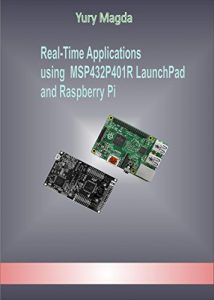A popular Raspberry Pi miniature computer is often used for designing measurement and control systems by professionals and hobbyists. Such systems can be driven via a general-purpose input/output port (GPIO) with pins accessible through header J8 on the Raspberry Pi board. With GPIO, user applications can process signals from various sensors and control external loads (relays, motors, etc.).
The only drawback is that Linux OS running on the Raspberry Pi is not suited for processing signals travelling via GPIO pins in real time. This prevents the Raspberry Pi from using in real-time applications that should process signals in a very short time. Meanwhile, Linux provides a powerful high-level environment for the development of GUI applications performing high-level data processing. It would be attractive to combine Linux high-level interfaces with real-time signal processing while building real-time applications.
One way to build real-time applications is to apply the combination of the Raspberry Pi and stand-alone microcontroller (MCU) development board capable of performing real-time tasks. In such configuration, the MCU board could process signals from sensors in real time, drive motors and actuators, etc. This development board could also execute commands from the Raspberry Pi and return data via some interface (parallel, UART, SPI, I2C, etc.).
On the other hand, the Raspberry Pi could perform non-critical operations including high-level processing the data obtained from the MCU board, data visualization and networking.
Such configuration can be used, for example, in image, video and audio processing systems. In those systems, the Raspberry Pi could process the image or video from cameras, while a stand-alone microcontroller module could control a precision motor positioning a camera.
This book is dedicated to designing real-time applications using the Raspberry Pi 2 board and very low-cost but effective MSP-EXP432PR401™ LaunchPad by Texas Instruments. The book contains various practical examples of applications processing digital and analog signals in real time; each project is accompanied by the detailed description of the hardware and program code being used.
All projects were designed using the Raspberry Pi 2 board running Raspbian OS, although developers can use the earlier versions of the Raspberry Pi board as well. All of the source code for the Raspberry Pi projects was developed in the Python environment running in Raspbian OS. The program code for MSP-EXP432P401R LaunchPad was developed using Energia MT IDE and Code Composer Studio 6.1.0 by Texas Instruments. Most projects described in this book can be easily improved or modified if necessary.
The only drawback is that Linux OS running on the Raspberry Pi is not suited for processing signals travelling via GPIO pins in real time. This prevents the Raspberry Pi from using in real-time applications that should process signals in a very short time. Meanwhile, Linux provides a powerful high-level environment for the development of GUI applications performing high-level data processing. It would be attractive to combine Linux high-level interfaces with real-time signal processing while building real-time applications.
One way to build real-time applications is to apply the combination of the Raspberry Pi and stand-alone microcontroller (MCU) development board capable of performing real-time tasks. In such configuration, the MCU board could process signals from sensors in real time, drive motors and actuators, etc. This development board could also execute commands from the Raspberry Pi and return data via some interface (parallel, UART, SPI, I2C, etc.).
On the other hand, the Raspberry Pi could perform non-critical operations including high-level processing the data obtained from the MCU board, data visualization and networking.
Such configuration can be used, for example, in image, video and audio processing systems. In those systems, the Raspberry Pi could process the image or video from cameras, while a stand-alone microcontroller module could control a precision motor positioning a camera.
This book is dedicated to designing real-time applications using the Raspberry Pi 2 board and very low-cost but effective MSP-EXP432PR401™ LaunchPad by Texas Instruments. The book contains various practical examples of applications processing digital and analog signals in real time; each project is accompanied by the detailed description of the hardware and program code being used.
All projects were designed using the Raspberry Pi 2 board running Raspbian OS, although developers can use the earlier versions of the Raspberry Pi board as well. All of the source code for the Raspberry Pi projects was developed in the Python environment running in Raspbian OS. The program code for MSP-EXP432P401R LaunchPad was developed using Energia MT IDE and Code Composer Studio 6.1.0 by Texas Instruments. Most projects described in this book can be easily improved or modified if necessary.






